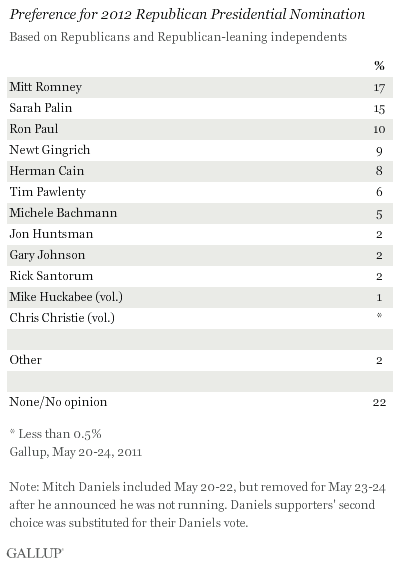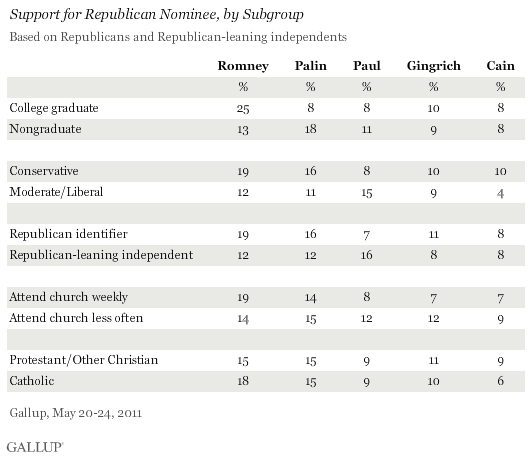PRINCETON, NJ -- Mitt Romney (17%) and Sarah Palin (15%) now lead a smaller field of potential Republican presidential candidates in rank-and-file Republicans' preferences for the party's 2012 nominee. Ron Paul, Newt Gingrich, and Herman Cain essentially tie for third, with Cain registering 8% support in his initial inclusion in ���۴�ý"trial heat" polling. Notably, 22% of Republicans do not have a preference at this point.

The May 20-24 poll is the first update of Republican nomination preferences after a recent flurry of activity in the race for the 2012 nomination, with several formally declaring their presidential candidacies, including Paul, Gingrich, Tim Pawlenty, and Cain.
Perhaps as significant were the decisions by Mike Huckabee, Donald Trump, and Mitch Daniels to forgo the race. In Gallup's April update, , with Huckabee placing first in .
Of the 10 candidates included in the newly reduced list, 7 have either officially announced their candidacies or established exploratory committees. Jon Huntsman and Michele Bachmann are nearing decisions and are expected to get in the race, while Palin's status as a candidate is less certain.
Re-allocating Palin supporters' votes to the candidate who is their second choice gives a sense of where current preferences would stand without Palin in the mix. Under this scenario, Romney leads with 19%, followed by Gingrich and Paul with 12% each.

Romney's and Palin's status at the top of the field is owing in large part to their high name identification among rank-and-file Republicans. Gingrich and Paul are also well-known among the party base. Cain, on the other hand, is far less well-known, but he has generated , which allows him to place ahead of slightly better-known candidates such as Bachmann, Pawlenty, and Santorum.
Romney's Support Varies by Education
Romney's appeal is much greater among college graduates (25%) than nongraduates (13%). Palin, meanwhile, fares better among nongraduates (18%) than college graduates (8%). The remaining candidates have fairly similar support by education.
Romney and Palin generally do better among conservatives than liberals and moderates. Paul is competitive with Romney and Palin for the top spot among liberals and moderates, though even combined, these groups make up a much smaller segment of the Republican base than conservatives do.
Further evidence that Paul's support generally lies outside the Republican mainstream is that Republican-leaning independents are twice as likely to support him as are those who identify outright as Republicans. Romney and Palin lead among the larger group of Republican identifiers.
Romney is the leading candidate among churchgoing Republicans, at 19%. Among Republicans who identify as Protestant or some other Christian religion (other than Catholic or Mormon), his support is 15%, tying him with Palin as the leader among that group. This is notable given that some think Romney's Mormon faith could hurt his support among Protestants.

Implications
In the short term, Romney and Palin seem to have benefited most from several prominent potential Republican candidates' decisions not to run for president. Should Palin follow suit and not enter the race, Romney would be the clear front-runner, but .
As such, the race remains wide open, which is underscored by the fact that one in five Republicans currently have no preference.
Track every angle of the presidential race on Gallup.com's Election 2012 page.
Survey Methods
Results for this ���۴�ýpoll are based on telephone interviews conducted May 20-24, 2011, on the ���۴�ýDaily tracking survey, with a random sample of 971 Republicans and Republican-leaning independents, aged 18 and older, living in all 50 U.S. states and the District of Columbia.
For results based on the total sample of Republicans, one can say with 95% confidence that the maximum margin of sampling error is ±4 percentage points.
Interviews are conducted with respondents on landline telephones and cellular phones, with interviews conducted in Spanish for respondents who are primarily Spanish-speaking. Each sample includes a minimum quota of 400 cell phone respondents and 600 landline respondents per 1,000 national adults, with additional minimum quotas among landline respondents for gender within region. Landline telephone numbers are chosen at random among listed telephone numbers. Cell phones numbers are selected using random digit dial methods. Landline respondents are chosen at random within each household on the basis of which member had the most recent birthday.
Samples are weighted by gender, age, race, Hispanic ethnicity, education, region, adults in the household, and phone status (cell phone-only/landline only/both, cell phone mostly, and having an unlisted landline number). Demographic weighting targets are based on the March 2010 Current Population Survey figures for the aged 18 and older non-institutionalized population living in U.S. telephone households. All reported margins of sampling error include the computed design effects for weighting and sample design.
In addition to sampling error, question wording and practical difficulties in conducting surveys can introduce error or bias into the findings of public opinion polls.
For more details on Gallup's polling methodology, visit .
